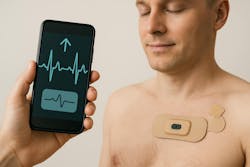Healthcare technology is at the center of both social and technological trends driving the use of wearable sensors that can harness both local and remote intelligence to deliver more effective, personalized treatment. As a result, demands grow louder for sensor quality and embedded processing capability coupled with the need to use integration to minimize size and energy usage.
One of the most significant forces behind this shift is aging. In many countries, the average age of the population is increasing, leading to a rise in chronic conditions such as diabetes, hypertension, and chronic obstructive pulmonary disease (COPD). These illnesses often require continuous monitoring and long-term management.
Wearable sensors can provide early indications of changes in health that need treatment by medical professionals. They also deliver personalized information that people can use to better manage their conditions.
To do so, wearable devices are harnessing technologies such as machine learning and artificial intelligence (AI) to recognize patterns that emerge from different combinations of sensors.
Integration into a Single ASIC
Because these devices increasingly depend on a wide range of embedded sensors, integrating all of the processing circuitry into an application-specific integrated circuit (ASIC) can pay dividends. By designing a chip specifically around the sensor interface and signal chain, engineers can achieve improvements in noise performance, power consumption, and size.
In wearable, implantable, and disposable medical devices, space is limited, power budgets are tight, and regulatory compliance requires predictable performance. Integrating several different sensing channels into a single ASIC addresses these challenges, enabling compact designs without sacrificing signal quality or system robustness. However, integration comes with its own complexities.
Each type of sensor requires a front-end fine-tuned to its specific requirements. It also requires deep expertise in mixed-signal ASIC design to make sure that these sensors work together without interference.
Temperature Sensors
Temperature sensing plays both a primary and a supporting role in medical devices. By itself, keeping tabs on temperature can be used to track fever, detect inflammation, or monitor the healing process. However, it’s also frequently used to help compensate for drift in other types of sensor inputs.
Temperature sensors can be embedded directly into the ASIC using bandgap references, diode junctions, or other thermal sensing structures. Integrating the sensors into the silicon ensures tight coupling to other sensing blocks. Furthermore, it reduces latency and power draw, which are ideal when it comes to wearable or implanted devices where battery runtime and thermal stability are vital.
>>Download the PDF of this article
Over the 35 to 45°C range, absolute temperature accuracy of less than ±0.1°C is possible with well-designed circuits and simple production calibration techniques.
Optical Sensors
Optical sensing comes in many forms, including photoplethysmography (PPG), pulse oximetry (SpO2), and fluorescent or absorbance-based chemical detection. In the context of most smart watches and other wearables in the “wellness” category, optical sensing involves shining light, typically in the red or infrared spectrum, into the body and measuring how much is reflected or transmitted.
For instance, PPG sensors detect blood volume changes in tissue to infer heart rate, blood oxygen level, or blood pressure. Fluorescence-based optical sensors detect biological markers, including metabolites and pathogens.
As medical-grade devices increasingly adopt these types of sensors, the technical requirements for the analog front-end (AFE) and digital signal processing (DSP) are trending up. Accurately detecting changes in blood flow or tissue composition depends on tightly controlled light emission and precise photodetection.
To support optical sensing, the ASIC requires high-efficiency LED drivers, precise timing-control logic, and photodiode interfaces with high dynamic range — all augmented with ambient light rejection techniques. Multi-wavelength sensing is driving the demand for advanced LED driver arrays with programmable currents and precise timing logic for multiplexed operation.
This integration enables synchronous sampling and modulation schemes that are essential for separating signals from background noise, especially in motion-prone environments. Power efficiency remains critical, so architectures rely on duty-cycled LED driving, low-leakage biasing, and dynamic scaling.
ECG and Biopotential Sensors
Electrocardiography (ECG) remains a cornerstone of cardiac monitoring, both in hospital settings and increasingly in ambulatory devices. Capturing ECG signals requires measuring minute voltage differences — typically less than 1 mV — across the body, often in the presence of significant common-mode noise.
Biopotential-sensing ASICs must offer high input impedance, excellent common-mode rejection, and low-noise performance. The same analog-design principles apply to EMG (for muscle monitoring) and EEG (for measuring brain activity), with adjustments in frequency response and gain configuration.
Bioimpedance and Respiratory Monitoring
Bioimpedance sensors measure the electrical resistance of body tissues, which can vary based on hydration, muscle tone, or respiratory state. One key application is respiratory rate monitoring, as chest impedance changes slightly with inhalation and exhalation.
ASICs designed for bioimpedance need to include programmable current drivers, demodulation blocks, and precise I/Q sampling paths. Some architectures support frequency sweeping for more advanced impedance spectroscopy, allowing for tissue characterization or detection of fluid accumulation.
Electrochemical Sensing
Electrochemical sensors are also increasingly vital. These sensors translate chemical reactions that occur when substances such as glucose or lactate interact with the surface of an electrode. They’re widely used for continuous glucose monitoring, lactate detection, and the lateral-flow diagnostics used for COVID-19 and HIV tests.
The front-end circuitry can detect and amplify signal from electrochemical sensors in several ways. Amperometric sensing measures current under constant voltage. Voltammetric sensing sweeps a voltage signal and observes the current response. Ratiometric sensing compares outputs from paired electrodes — one serving as a reference — to improve reliability and calibration.
Each form of signal analysis requires specific features in the AFE design. But they all suffer from the same challenges: minimizing noise, enabling low-current detection, and generating accurate, programmable bias voltages. For medical applications, even minute signal disturbances can matter.
Electrochemical sensing also underscores a broader engineering challenge: Extracting reliable data from inherently noisy environments. Low-level currents at the electrode-electrolyte interface are easily obscured by thermal noise, shot noise, and ionic drift. Environmental interference, ranging from the impact of 50/60-Hz mains power to wireless radio signals, can further compromise signal integrity.
When the analog ICs are placed one by one on a circuit board, these issues can be magnified. The relatively long interconnect traces increase parasitic capacitance and susceptibility to radiated or conducted noise.
Mixed-Signal ICs Separate the Signal from the Noise
Integrating the analog signal chain into the ASIC is about more than saving space. It also enables higher-accuracy monitors for everything from high and low heart-rate detection to blood oxygen and sleep-quality problems. The integration reduces the interconnect length and delivers more robust shielding against external noise. The shorter signal paths help to better match bias voltages, too.
But noise will also emanate from inside ASIC. Switching noise and substrate coupling from digital logic blocks may bleed into the analog side of the ASIC. Moreover, the analog circuitry can be a source of noise due to the low-level currents of electrochemical and other biomedical sensors.
Thermal and flicker noise — also called 1/f noise — generates in the transistors used for current mirrors and amplifiers. And at ultra-low current levels, it’s necessary to take noise from the analog-to-digital converter (ADC) stages into account.
To mitigate these effects, ASIC designers employ several techniques. Chopper-stabilized circuits and auto-zero amplifiers help suppress the effects of flicker noise and achieve stable low-offset operation. Sometimes, ratiometric or dual-electrode measurements are used not only for calibration, but also to cancel correlated noise.
Layout is equally critical to ensure good isolation between different parts of the ASIC and limit interference from digital processing. Floorplanning plays a crucial role as well, because short current-sensing routes combined with shielded interconnects will reduce parasitics. Deep n-well isolation between digital and analog domains keeps noisy digital switching away from sensitive signal paths.
While different sensors require AFEs specific to each role, there are opportunities to share functions. For example, integrating bioimpedance into an ASIC also allows for the sharing of circuitry with ECG channels: These sensors use similar electrode configurations and front-end requirements. Other system-level considerations include the power management of each sensor subsystem, as each will have different duty-cycle requirements that influence overall power use.
In addition, these ASICs can be designed to operate along with wireless SoCs, such as Bluetooth LE or near-field communications (NFC) modules. By decoupling communication and sensing, the IC can be reused across product lines with different connectivity needs.
On top of that, standardizing the interface between sensor ASIC and wireless SoC makes it possible for engineers to swap wireless chips without redesigning the sensor hardware. This modularity is valuable for long-lifecycle or high-volume products, and it supports second-source flexibility.
ASICs Take the Pulse of the Growing Healthcare Market
Mixed-signal ICs are the backbone of everything from wearables to medical-grade point-of-care devices. The ability for a single chip to interface with several different sensors gives engineers more control over power, performance, and product differentiation. The result is not only better signal quality and lower power, but also the flexibility to serve a range of clinical and consumer needs with a shared silicon platform.
>>Download the PDF of this article
About the Author

Ian Lankshear
CEO, EnSilica
Ian Lankshear is the CEO and co-founder of EnSilica, a leading fabless design house focused on custom ASIC design as well as supply and design services. The company has extensive expertise in designing and supplying custom analog, mixed-signal, and digital ICs to its customers worldwide in the automotive, industrial, and consumer markets.



